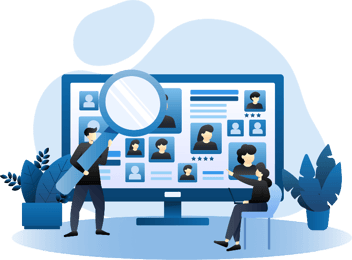Using Employer Branding to Keep Top Talent: Engage & Growth Strategies
In a world where the highly competitive job market, holding onto your best employees can make or break an organization's success. The key to achieving long-term success and staying ahead of the game is to focus on engaging and retaining top talent.
Retaining top talent is crucial in today's fiercely competitive job market, and a company's employer branding strategy is critical to achieving this. Employer branding encompasses an organization's values, culture, and mission, as well as the benefits and opportunities offered to its employees, and contributes to its image and reputation. With low unemployment rates and a shortage of skilled workers, companies must focus on team member engagement and retention to maintain a productive and stable workforce. One of the most effective ways to achieve this is by using employer branding to create an engaging workplace culture, communicate the company's values and mission to employees, and provide career growth and development opportunities. In this article, we will discuss these strategies in more detail.
With low unemployment rates and a shortage of skilled workers, companies must focus on team member engagement and retention to maintain a productive and stable workforce. One of the most effective ways to achieve this is by using employer branding to create an engaging workplace culture, communicate the company's values and mission to employees, and provide career growth and development opportunities. In this article, we will discuss these strategies in more detail.
Creating an Engaging Workplace Culture
To keep your top talent engaged and motivated, it's crucial to cultivate an inspiring workplace culture where employees feel valued and supported. A dynamic and engaging culture fosters a sense of purpose and ownership, driving your employees to do their best work. Here are some valuable strategies for nurturing an engaging workplace culture:
-
Foster open communication: Encourage open communication between employees and management. This includes providing regular feedback, listening to team members' concerns and suggestions, and creating an environment where employees feel comfortable sharing their ideas and opinions.
-
Provide a positive work environment: Create a positive one that promotes collaboration, creativity, and innovation. This includes offering comfortable and inspiring workspaces, providing employees with the necessary tools and resources to do their jobs effectively, and promoting a healthy work-life balance.
-
Celebrate successes: Celebrate team members' successes and milestones to create a positive and supportive work environment. This includes recognizing employees for their accomplishments, providing incentives and rewards for high-performing employees, and creating a culture of appreciation and gratitude.
Communicating Your Company's Values and Mission to Employees
To truly engage and retain top talent, it's crucial to communicate your company's values and mission to your employees. When your employees understand and align with the company's vision, they become more invested in their work and commit to achieving long-term success. Here are some effective strategies for effectively communicating your company's values and mission to your employees:
-
Provide regular updates: Provide regular updates on the company's progress, goals, and values to keep employees informed and engaged. This includes sharing company news and updates, providing regular performance feedback, and creating opportunities for team member feedback and communication.
-
Lead by example: Embodying the company's values and mission in your work and behavior. This includes promoting transparency, honesty, and integrity and modeling the desired behaviors and attitudes for employees to follow.
-
Involve employees in decision-making: Involve employees in decision-making processes to create a sense of ownership and investment in the company's goals and values. This includes soliciting feedback and suggestions, empowering employees to make decisions and take ownership of their work, and creating opportunities for collaboration and teamwork.
Creating Opportunities for Career Growth and Development
Providing avenues for career growth and development is crucial in keeping employees engaged and committed for the long haul. By offering opportunities for upskilling, tackling new challenges, and advancing their careers within the organization, employees are more likely to stay invested in the company's success. Here are some practical ways to create such opportunities:
-
Offer training and development programs: Offer training and development programs to help employees learn new skills and advance their careers. This includes providing access to workshops, seminars, and conferences and creating on-the-job learning and skill-building opportunities.
-
Create career paths: Create clear career paths and development plans for employees to help them understand how to advance within the company. This includes setting clear goals and expectations for employees, providing regular feedback and support, and offering opportunities for advancement and growth.
-
Provide mentorship and coaching: Provide mentorship and coaching opportunities to help employees develop their skills and build their careers. This includes pairing employees with experienced mentors and coaches, providing regular feedback and support, and creating a culture of continuous learning and development.
Effective Employee Retention Strategies
Retaining top talent is critical for companies to maintain a stable and productive workforce and avoid the costs and disruptions associated with high turnover rates. Therefore, effective team member retention strategies must also be a focus in addition to team member engagement strategies. Companies can use strategies to increase team member retention, such as offering competitive compensation and benefits, creating a positive work-life balance, and providing a clear career path.
-
Offer competitive compensation and benefits: Offering competitive compensation and benefits is critical for retaining top talent. This includes offering competitive salaries, bonuses, and benefits packages.
-
Foster a positive work-life balance: A positive work-life balance is essential for team member retention. This includes offering flexible work arrangements, providing paid time off, and promoting a healthy work-life balance.
-
Create a sense of community and belonging: Employees are likelier to stay with a company if they feel a sense of community and belonging. This can be achieved through team-building activities, social events, and team member resource groups.
-
Recognize and reward team member contributions: Recognizing and rewarding team member contributions is an effective way to retain top talent. This includes offering bonuses, promotions, and other incentives for high-performing employees.
-
Conduct regular team member surveys: Regular surveys among team members can identify areas for improvement and increase team member satisfaction and retention. These surveys can gather valuable feedback on factors such as company culture, work-life balance, compensation, and other key areas that impact team member retention.
Benefits of Using Employer Branding for Employee Engagement and Retention
Employer branding can create a more stimulating and fulfilling workplace culture, effectively communicate the company's values and mission, and provide opportunities for personal and professional growth. As a result, it offers numerous benefits for team member engagement and retention, including heightened morale and motivation, increased innovation and creativity, and enhanced employer brand reputation.
-
Improved team member morale and motivation: When employees feel valued, supported, and invested in the company's success, they are more likely to feel motivated and committed to their work. This can improve morale, higher productivity, and better overall performance.
-
Higher retention rates: Employees who feel engaged and satisfied with their work are less likely to leave the company. This can help reduce turnover rates and save the company time and money on recruitment and training.
-
Enhanced employer brand reputation: A strong employer brand can help attract top talent and enhance the company's reputation as an employer of choice. This can help the company stand out in a competitive job market and attract the best candidates for open positions.
-
Increased innovation and creativity: An engaging workplace culture can help foster innovation and creativity by promoting collaboration and risk-taking. This can lead to new ideas and approaches that benefit the company's bottom line.
In today's competitive job market, companies must prioritize engaging and retaining their top employees for a stable and thriving workforce. One proven approach to achieving this is by utilizing employer branding strategies to establish an inspiring workplace culture, communicate company values and mission, and offer opportunities for career growth.
By promoting transparent communication, cultivating positivity, recognizing individual achievements, providing regular updates, leading by example, involving employees in decision-making, facilitating training and development, creating clear career paths, and offering mentorship and coaching, companies can create a culture of support and engagement that keeps their best employees committed for the long-term.
This content is also available in:
- German: Employer Branding zur Bindung von Spitzenkräften
- Spanish: Marca empleador para retener talentos: Estrategias de crecimiento
- French: Rétention des meilleurs talents par la marque employeur
- Italian: Employer Branding per trattenere i migliori talenti
- Romanian: Employer Branding: Păstrarea talentelor de top
- Chinese: 利用雇主品牌留住顶尖人才:参与和增长战略

Claudia, a People Operations leader with 9+ years of experience in HR strategy, employer branding, and employee engagement, has guided human resources functions for several high-growth international companies. She played a key role in developing the global employer branding strategy at UiPath during its critical expansion phase. Claudia's expertise lies in scaling People Operations and building the essential HR frameworks that enable dynamic companies to grow effectively.





.png?width=352&name=What%20Does%20it%20Mean%20to%20Have%20Branding%20Guidelines%20(1).png)
Leave a Comment